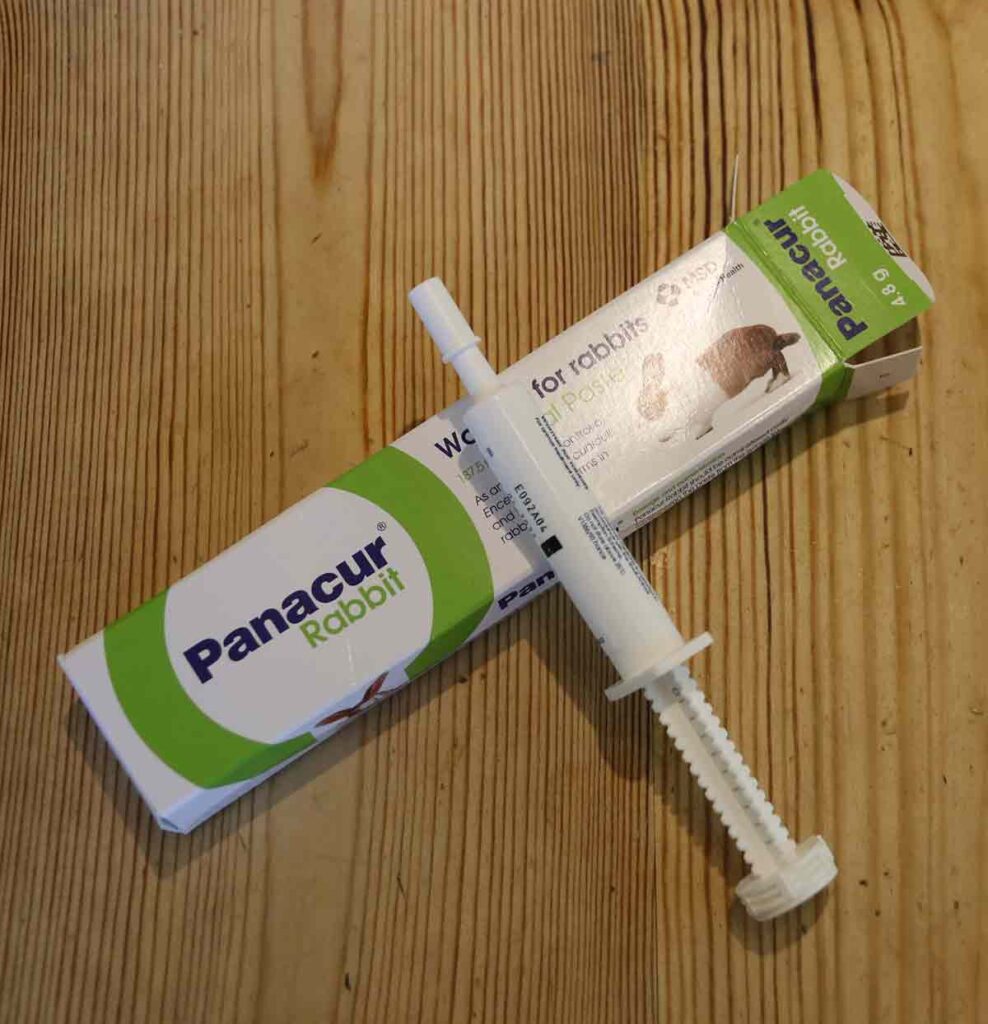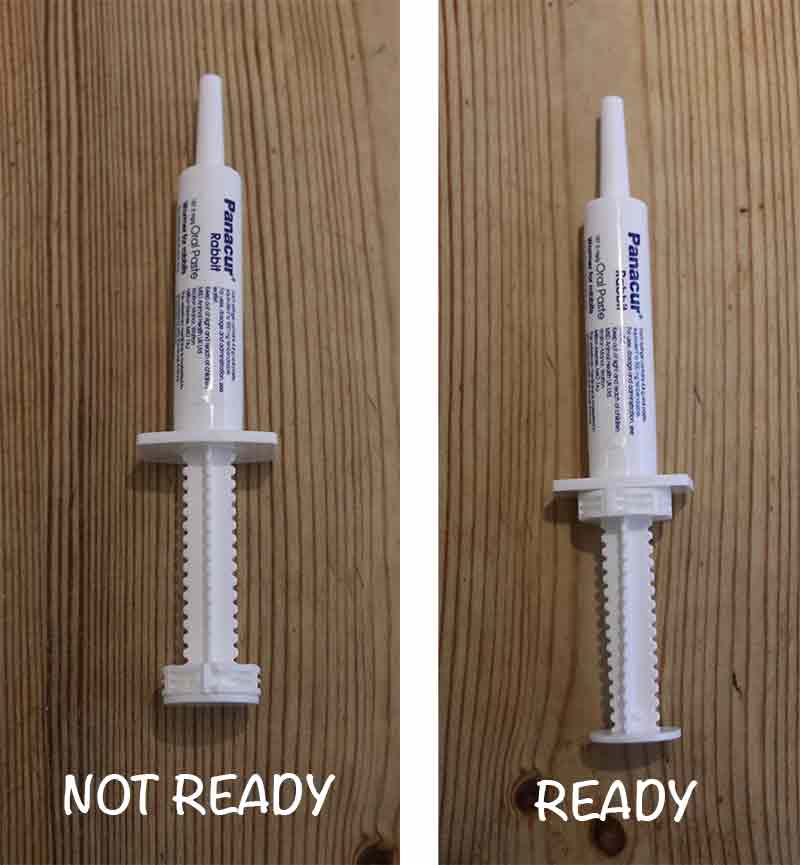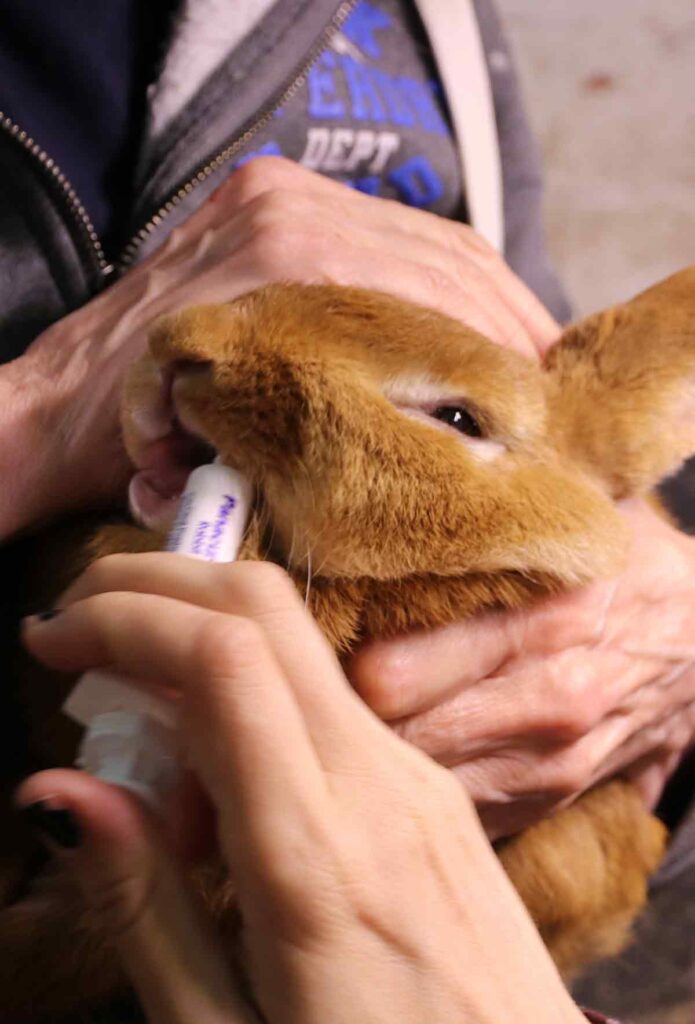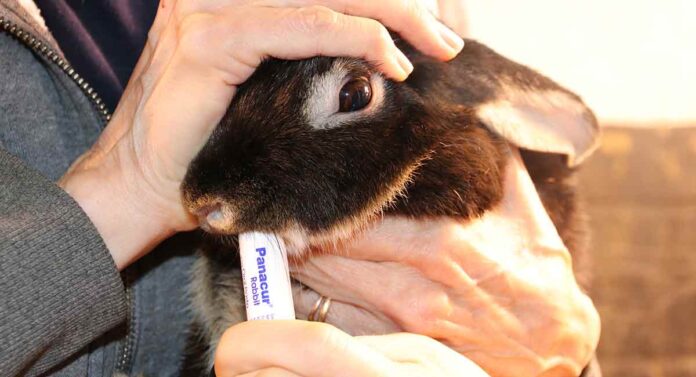When your rabbit is sick, it’s good to get a diagnosis and know that there is a treatment available. But having the treatment, and getting it into your rabbit are two very different things!
I’ve recently had to treat several rabbits with Rabbit Panacur and I can confirm that it can be challenging to administer. So I’ve included several tips and techniques to make sure that white paste ends up inside your rabbit, and not all over you.
Why your pet might need Panacur for rabbits
Rabbit panacur is a rabbit wormer, and it is also used to treat rabbits for a very nasty microsporidial parasite called E. Cuniculi

This is a microscopic organism that has some similarities with protozoans, and some similarities with fungi. The first symptoms of infection in rabbits include urinary incontinence or a head tilt. Left untreated some rabbits will die and some will be sick for a long time and left with permanent health problems.
Other things can cause incontinence or head tilt in rabbits so you will need to get a vet to examine your rabbit and make a diagnosis. If they suspect E Cuniculi they will probably prescribe a 28 day course of Panacur for rabbits.
The active ingredient in Rabbit Panacur is fenbendazole, and fenbendazole for rabbits is considered a very safe drug.
Panacur recommends two different treatment regimes, one for treating a sick rabbit, and one for preventing infection in rabbits that are vulnerable. The prevention regime is just 9 days. Either way, that’s quite a few doses for you to administer and the better your technique for doing that, the easier it will be.
Can’t I use puppy panacur?
Panacur rabbit wormer is expensive and if you have some puppy Panacur handy you may be tempted to use this instead.
Don’t do this.
Puppy Panacur is intended to be palatable for puppies. I haven’t tasted it but I’m guessing it will be meat flavored.
No self respecting rabbit is going to let that anywhere near their mouth, let alone swallow it.
Rabbit panacur is designed to be palatable to rabbits, not puppies. Most likely it’s flavored to taste like their favorite sugary treats. And with a bit of luck, you might just be able to get your rabbit to eat it without any handling at all.
Free feeding Rabbit Panacur
Occasionally it is possible to get a rabbit to eat the Panacur of its own free will. Cut some small willow or hazel twigs or some other edible stalk that you can use to dip into the panacur paste. Squeeze the correct dose of panacur into a spoon, and dip the end of the twig into it.
Hold it out just in front of your rabbits mouth
With a bit (a lot) of luck, your rabbit may eat the paste off the end of the twig. Then you can simply dip and repeat. If the rabbit won’t take it, you’ve wasted one dose, and no harm done.
Let’s be honest here, only one of my nine rabbits is willing to do this. So while it’s worth a try, you’re probably going to need to go in a bit closer!
If your rabbit won’t eat the paste off a twig, then it’s time to get up close and personal. You’re going to need to grasp your rabbit firmly and hold them very still, while a friend inserts the syringe into their mouth and presses the plunger. It is possible to do this on your own, but technique is everything here.
Medicating a rabbit with two people
I’ll explain how to do this with two people first. It really is much better for you and your rabbit if you get someone to help you with this.
I appreciate that this isn’t possible for everyone, so I’ll give you some tips for single handed administration next.
Understanding the syringe and graduations
The panacur syringe plunger has serations and lines along its length to define the graduations for each dose. These are not easy to use. Its important to read the instructions where there are good diagrams that show you exactly how far apart a single graduation is.
Warning – avoiding overdose
When you open the box of Panacur paste and take out the syringe, you’ll see that there is a dial ring directly beneath the top of the syringe plunger. This ring must be screwed all the way down to the bottom of the plunger before you start administering the paste.
I feel that distributing these syringes with the dial ring at the top is a flaw in the design, making it too easy to give an overdose by calculating graduations from the top of the plunger instead of from the bottom.
I’ve done this myself after sleepless nights up with a sick puppy, and it is easily done if you are not concentrating. So to reiterate, It’s vital that you screw the dial ring down to the bottom, before you turn it to the correct number of graduations.
Preparing the syringe
Read the instructions in the box carefully and screw the dial ring down to the bottom of the plunger so that it butts up almost against the body of the syringe. You’ll see a tiny zero that you can line up the dial ring with.

Then turn the dial ring back up the correct number of graduations. At the time of writing my rabbits need two syringe graduations because they weigh between 5.5lbs to 11lbs (2.5 to 5Kg)
It’s important that you follow the instructions in the box and don’t rely on what I say here, or on what any other website says (apart from the manufacturer) with regard to doses, or procedures because instructions may change over time and you need the latest information supplied by Panacur.
How to hold your rabbit for medication
You’ll need to have your rabbit in a fairly upright position, hugged tight against your body. Pin the rabbit against your body with one hand, and with the other hand steady the rabbit’s head. It’s important that you hold the head still.

Your assistant won’t be able to get the syringe in if your rabbit is able to turn their head or swipe across their face with their front paws.
I like to tuck the rabbit’s back legs behind me with my left arm along the length of their body. This leaves my right hand to steady the rabbit’s head
Rear paws must be firmly pinned against you or the rabbit will use those to push you away and rabbit claws can cause nasty cuts in human skin
Practice holding your rabbit tight before you start messing with medicine. If you cannot do it then you are going to need to swaddle your rabbit in a towel.
Inserting the syringe
It’s tempting to try to get into a rabbit’s mouth at the center front where the lips part in the middle.
It looks like the way in, but you do not want to go in via the front door! It won’t work as the syringe will be barred by some hefty front teeth.
You need to go around to the side of the rabbit’s mouth, just behind the front teeth where there is a nice big gap. And to do this, you’ll need to lift the lip with the end of the syringe, then with the syringe pointing upwards towards the roof of the rabbits mouth, slide it in behind the front teeth and press the plunger.
Most rabbits will start licking and swallowing as soon as you press the plunger. Some shyer rabbits will wait until you put them down.
Growling and biting
My current rabbits are pretty good tempered. But not all rabbits will take kindly to being handled and grasped firmly enough to administer medicine.
If your rabbit growls and thumps their feet at you when you try to pick them up, take this seriously for the warning that it is.
Rabbit bites can really hurt, so you need to medicate aggressive rabbits with care.
Unless you are very experienced at handling strong, lively rabbits, you’ll need to wear some gloves and wrap your rabbit in a towel with just their head poking out. Use a big towel and drop it over the rabbit before scooping them up with the towel around them.
Medicating a rabbit on your own
With practice you should be able to tuck the rabbit under your arm, pin them against you with your forearm and with the hand on the same arm steady the rabbits head.
This leaves your other hand free to administer the medicine.
It isn’t particularly easy, but you will get better with practice.
Get well soon
Giving medicine to small pets can be challenging, but it’s great to know you have done something positive towards helping them recover or avoid potentially serious health issues.
Good luck with your rabbit, and if they are sick I hope they get better soon!
References
Latney, Bradley & Wire. Encephalitozoon cuniculi in pet rabbits: diagnosis and optimal management. Veterinary Medicine research and reports. Dec 2022














